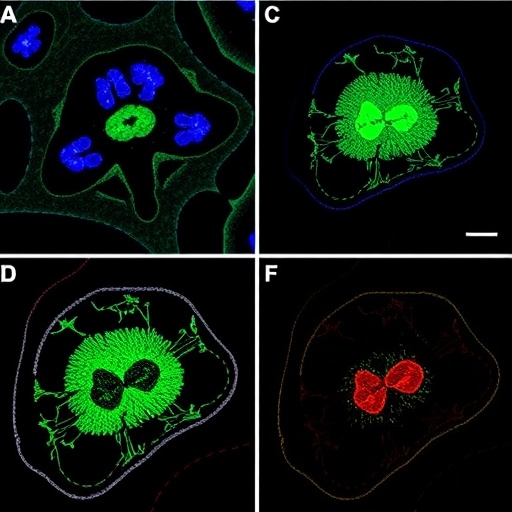Salivary gland carcinomas, though rare, represent a complex oncological challenge due to their heterogeneous histology and often poor outcomes, particularly in advanced stages. A groundbreaking study from Vietnam has now shed new light on the molecular landscape of these malignancies, focusing on the expression of two critical biomarkers—CD73 and vascular endothelial growth factor (VEGF). This research not only broadens our understanding of tumor biology in a Southeast Asian population but also opens exciting avenues for targeted therapies in salivary gland cancers.
Understanding the molecular drivers of salivary gland carcinomas is pivotal. Among numerous candidates, CD73 and VEGF have emerged as potent players in tumor progression. CD73, an ecto-5′-nucleotidase, modulates the tumor microenvironment by generating immunosuppressive adenosine, thereby facilitating immune evasion and fostering tumor growth. Meanwhile, VEGF is a prime regulator of angiogenesis, promoting vascular proliferation essential for tumor nourishment and metastasis. Despite their recognized roles in various cancers, data on their expression and clinical relevance in salivary gland tumors, especially within Asian cohorts, has been limited.
The Vietnamese study retrospectively analyzed 111 patients diagnosed with salivary gland carcinomas, all surgically treated in Ho Chi Minh City. Employing immunohistochemical techniques, the researchers quantified CD73, VEGF, and Ki-67 expressions in tumor tissues preserved in paraffin blocks. Ki-67, a well-established proliferation marker, provided additional insight into tumor aggressiveness. Using logistic regression models, the study parsed out clinicopathological factors linked to biomarker expression, revealing critical correlations that have implications for prognosis and therapy.
Results indicated that CD73 was expressed in just over half (53.2%) of cases, while VEGF expression was even more prevalent, identified in 66.7% of tumors. Intriguingly, CD73 expression demonstrated a significant positive association with multiple factors. Female patients exhibited higher odds of CD73 positivity, suggesting potential gender-related biological or hormonal influences on tumor microenvironment modulation. More aggressive tumor stages, specifically T2 and T4, were strongly linked to elevated CD73 levels, underscoring the enzyme’s involvement in disease progression.
Histological subtype analysis highlighted that mucoepidermoid carcinoma, a frequent and heterogenous variant of salivary gland cancer, had a markedly higher likelihood of CD73 expression compared to other subtypes. The correlation between CD73 and increasing Ki-67 index further corroborates the enzyme’s association with cellular proliferation and tumor aggressiveness. Intriguingly, lymph node involvement at the N2 level showed an inverse association with CD73, hinting at a complex interaction between tumor dissemination and immune modulatory factors.
VEGF expression patterns were equally compelling. Patients maintaining a normal body mass index (BMI) were significantly more likely to express VEGF than those classified as overweight or obese. This finding reverses some prior assumptions about obesity’s direct link to tumor angiogenesis and invites deeper investigation on metabolic influences in salivary gland carcinomas. Similar to CD73, VEGF expression was positively correlated with higher Ki-67 proliferation rates, reaffirming its role in facilitating rapid tumor cell growth via neovascular support.
The dual expression of CD73 and VEGF illustrates how salivary gland tumors might leverage multiple biological pathways to sustain growth, evade immune detection, and promote metastasis. CD73’s role in immunosuppression and VEGF’s in angiogenesis highlight complementary mechanisms by which tumors can adapt to hostile environments and therapeutic pressures. This dual biomarker expression profile could therefore serve as both a prognostic indicator and a therapeutic target.
The Vietnamese cohort study is particularly noteworthy given the population-specific insights it offers. Genetic diversity, lifestyle factors, and unique environmental exposures influence cancer biology, and data from Southeast Asia has been sparse regarding salivary gland malignancies. By focusing on this population, the study fills a critical gap and suggests that biomarker-driven personalized therapies could be tailored more precisely for Vietnamese patients and potentially other similar demographic groups.
Moving forward, these findings call for further experimental validation and clinical trials investigating CD73 and VEGF as therapeutic targets. Inhibitors of CD73, some currently in clinical development, could enhance anti-tumor immune responses by reversing adenosine-mediated immunosuppression. Similarly, anti-VEGF therapies, which have shown promise in other solid tumors, might suppress tumor angiogenesis and growth in salivary gland carcinomas. Combining such targeted approaches with conventional treatments could improve survival and reduce recurrence.
Moreover, the observed associations with tumor stage, histology, BMI, and proliferation underscore the importance of integrating clinical parameters with molecular profiling. Such integration might refine risk stratification and guide treatment decisions, moving closer to the era of precision oncology. For instance, patients exhibiting both high CD73 and VEGF expression could be prioritized for novel combinatorial therapies targeting both angiogenesis and immune checkpoints.
This research also opens potential pathways for non-invasive diagnostic strategies. Elevated CD73 and VEGF levels might be detectable in circulating tumor cells or patient serum, serving as biomarkers for early detection and monitoring therapeutic response. As liquid biopsy techniques evolve, these markers could play dual roles in diagnosis and real-time treatment assessment.
However, challenges remain. The variable expression patterns of these biomarkers across different tumor subtypes necessitate large-scale, multicenter studies to validate their universal applicability. Additionally, the interplay between metabolic factors like BMI and tumor biology requires deeper exploration to unravel mechanisms affecting VEGF expression and angiogenesis in the tumor microenvironment.
In conclusion, the Vietnamese study delivers significant advancements in our understanding of salivary gland carcinomas, highlighting CD73 and VEGF as pivotal biomarkers linked with tumor behavior and clinical characteristics. These insights pave the way for biomarker-driven therapeutic strategies that hold promise in enhancing patient outcomes. As oncology continues to embrace molecular precision, such research marks a critical step toward more effective, personalized cancer care for diverse populations worldwide.
Subject of Research: Expression of CD73 and VEGF in salivary gland carcinomas and their associations with clinicopathological characteristics in Vietnamese patients.
Article Title: Expression of CD73 and VEGF in salivary gland carcinomas: associations with clinicopathological characteristics in Vietnamese population
Article References:
Nguyen, T.D., Nguyen, H.T., Huynh, C.G. et al. Expression of CD73 and VEGF in salivary gland carcinomas: associations with clinicopathological characteristics in Vietnamese population. BMC Cancer 25, 1678 (2025). https://doi.org/10.1186/s12885-025-15129-1
Image Credits: Scienmag.com




